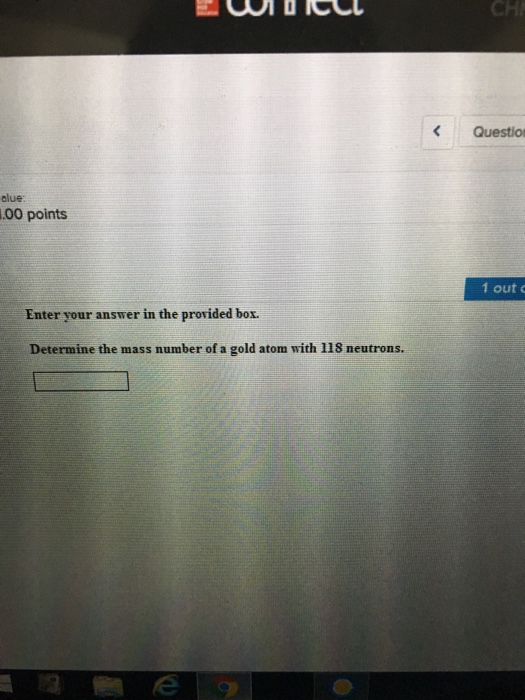- Number Of Valence Electrons In Gold
- What Is The Atomic Mass Of Gold
- Gold Atomic Mass Number
- Gold's Mass Number
- Older gold may not be stamped but is usually 9k. Look for numbers in the hundreds, such as '333,' which is 8k or about 33 percent gold. Gold can be all the way up to 24k, 999 or 9999, which indicates about 99 percent pure gold. There are about a dozen numbers in between, from 10k or 417 to 23k or 950.
- Do a quick conversion: 1 moles Gold = 196.96655 gram using the molecular weight calculator and the molar mass of Au. Check the chart for more details.
Chemical elements listed by atomic mass The elements of the periodic table sorted by atomic mass. Click on any element's name for further information on chemical properties, environmental data or health effects. This list contains the 118 elements of chemistry. Example 1 - mass number of Gold: The element Gold (Symbol Au) has the Atomic Number of 79. The number of protons in atom of gold is therefore 79. Gold has the Atomic Mass weight of 196.97. Round to the nearest whole number. The mass number of gold is therefore 197. Example 2 - mass number of Silver: The element Silver (Symbol Ag) has the Atomic. Au, which is also its only naturally occurring isotope, so gold is both a mononuclidic and monoisotopic element. Thirty-six radioisotopes have been synthesized, ranging in atomic mass from 169 to 205. The most stable of these is 195 Au with a half-life of 186.1 days.
Measurement Unit For Gold
Measurement Unit For Gold - Gold Price
Gold is as an investment product, its price is extremely important for the investors. However, in the same time, the gold price is varying from measurement unit. In the gold market, the different countries are with different habits, rules and local measurement units, therefore, the measurement units of the world gold trading are different. The following lists several more common measurement units in the international gold markets:
First of all, let's understand some information about Troy Weight. Troy weight is a system of units of mass; it is customarily used for precious metals and gemstones, such as gold, silver, and gemstones. 1 troy pound is equal to 12 troy ounces, distinguishing from avoirdupois system (16 ounces per pound). The units of measurement are troy pound, troy ounce, and pennyweight and so on.
Troy ounce (abbreviated 'oz t')

Troy ounce is commonly used to measure the mass of precious metals, such as gold. 1 troy ounce is equal to 31.1034768 grams, or 1/12 per troy pound (1 troy pound ≈ 373.24 grams, that is lighter than avoirdupois pound), distinguishing from avoirdupois ounce which equals to 28.3495231 grams. In modern times, the troy ounce is the only measurement unit of troy weights system is widespread used in the British Imperial and American. In fact, the gold fixing price is based on the unit of troy ounce.
Pennyweight (abbreviated 'dwt')
Number Of Valence Electrons In Gold
Pennyweight is a unit of mass; it is mainly used in measurement of precious metals in North American. 1 pennyweight is equal to 1/20 of a troy ounce, or equal to 1.55517384 grams.
Then, list other units for gold measurement as following:

Gram (abbreviated 'g')
The gram is a metric system unit of mass, and it is also a SI derived unit. 1 gram = 0.001 kilogram.
Tola
The Tola is a traditional South Asian unit of mass, defined as 3/8 troy ounce, or approximately equals to 11.6638 grams. It is mainly used in trading gold of New Delhi, Karachi, Mumbai, etc.. In additional, Tola is as a unit of British Indian system of weights. It is equivalent to 10 grams. The latter Tola is popular used in gold bullion bars in Bangladesh, India, Nepal, Pakistan and Singapore.
Tael (or tahil)
Tael is most commonly used in Chinese, Hong Kong, Southeast Asia, and so on. In Chinese, 1 Tael = 50 grams, or =1.607536 troy ounces. In Hong Kong, 1 tael = 37.799364167 grams. In Japanese, 1 tael (両 ryō) = 37.5 grams.

Baht
Baht (Thai: บาท, sign: ฿; code: THB) is the foremost unit of weight for gold in Thailand. 1 baht = 15.244 grams.
What Is The Atomic Mass Of Gold
Grain

A grain is a measurement unit of mass which is a traditional unit and based on the weight of a grain of wheat. The grain is the smallest unit of weight in the troy, avoirdupois, and apothecaries systems. 1 grain = 0.0648 grams, or = 0.0020833 troy ounces.
Conversion Table
| Troy ounce | Gram | Kilogram | Tola (South Asia) | Tael (Hong Kong) | Tael (Japanese) | Grain | Baht | |
|---|---|---|---|---|---|---|---|---|
| Troy ounce | 1 | 0.03215075 | 32.15075 | 0.375 | 1.21528 | 1.205653 | 0.0020833 | 0.49 |
| Gram | 31.1034768 | 1 | 1000 | 11.6638 | 37.79936417 | 37.5 | 0.064798918 | 15.244 |
| Kilogram | 0.03110348 | 0.001 | 1 | 0.0116638 | 0.03779936 | 0.0375 | 6.47989-E4 | 0.015244 |
| Tola (South Asia) | 2.6666675 | 0.08573535 | 85.73535 | 1 | 3.2407418 | 3.2150757 | 0.005555558 | 1.30695 |
| Tael (Hong Kong) | 0.822857 | 0.0264555 | 26.4555 | 0.30857 | 1 | 0.99208 | 0.001714286 | 0.4032872 |
| Tael (Japanese) | 0.829426 | 0.026667 | 26.667 | 0.3110347 | 1.00798 | 1 | 0.00172797 | 0.406507 |
| Grain | 480 | 15.432356 | 15432.356 | 180 | 583.33326 | 578.7134 | 1 | 235.25084 |
| Baht | 2.040375 | 0.0656 | 65.6 | 0.76514 | 2.48 | 2.46 | 0.0425078 | 1 |
Gold: isolation
Isolation: it would not normally be necessary to make gold in the laboratory as it is readily available commercially. The most romantic way to extract gold is by panning it out from a stream in some pleasant valley but most such sources are now depleted. Panning relies upon the density of gold (which is very high) being much greater than that of the sand and other particulates. It therefore settles to the bottom of the pan. The amount of gold recoverable in this way is declining.
One suggestion regarding the golden fleece in the Jason and the Argonauts story (Greek mythology) is that the golden fleece is a consequence of gold mining. There are suggestions that, perhaps 1500 years ago sheep fleeces were stretched out over wooden frames and be submerged in streams. Gold particles swept down from from upstream deposits would then become embedded in them. The fleeces were then dried in trees before shaking or combing the gold out. Similarly, sheep fleeces may have been used on washing tables at alluvial gold mines with much the same effect. Perhaps such methods predated panning of gold from river sands.
Today, more often than not, gold is extracted from ores. These ores often contain relatively little gold. Some of these processes cause environmental concern. Much gold is recovered from ores that are low in gold concentration using a cyanide extraction process. Cyanide extraction was first used around 1887, when the MacArthur-Forrest Process was developed in Glasgow by John Stewart MacArthur. Many worry about the envoronmental effects of the cyanide extraction process and the risks of using cyanide on a large scale. There are three main steps.
The first step is leaching - the ore is crushed to a powder so as to expose the small gold particles. and mixed with water. The resulting mixture of powdered ore and water (the slury) is then reacted with cyanide in the presence of oxygen.
4Au(s) + 8CN-(aq) + 2H2O(l) + O2(g) → 4[Au(CN)2]-(aq) + 4OH-(aq)
The result is that electrons from oxygen are used to convert the gold metal into a Au(I) complex, [Au(CN)2]-. The acidity of the process must be slightly alkaline (pH 10.1 for instance) to minimise the release of highly toxic hydrogen cyanide while optimising the leaching rate.
The next stage is concentration. Once in solution the gold must be converted back to gold metal. One way to do this is by adsorption of the gold onto activated carbon. Most of the impurities are left behind in the solution. This would appear to cause some anion exchange of [Au(CN)2]- with anions associated with the carbon, the precipitation of insoluble AuCN, and the formation of some metallic gold within the carbon pore structure.
The final step is recovery and refining. Gold is stripped from the carbon by mixing it with NaCN and NaOH at 1108C forming a new solution of [Au(CN)2]-. This solution is now fairly pure as the activated carbon process removes many of the impurities. The gold is then converted back to elemental gold in the following electrolysis reactions known as 'electrowinning':
At the anode: 4OH- → O2 + 2H2O +4e-
At the cathode: e- + [Au(CN)2]- → Au + 2CN-
Overall: 4OH- + 4[Au(CN)2]- → 4Au + 8CN- + O2 + 2H2O

The gold is 'won' onto stainless steel electrodes or precipitated out as a fine black mud. The mud is then smelted and poured into moulds to make gold ingots.
As an laternative to this, zinc powder is added to the solution or reasonably pure of [Au(CN)2]-. This results in a metal displacement reaction:
2[Au(CN)2]-(aq) + Zn(s) -> [Zn(CN)4]2-(aq) + 2Au(s)
As before a fine black 'mud' of gold and residual zinc precipitates from the solution, which is then smelted.
Gold Atomic Mass Number
Extraction of gold from seawater
Gold's Mass Number
There is some gold in seawater, but the concentration of dissolved gold is very low, perhaps 10 ng l-1. The most determined attempt to recover gold from sea water was undertaken by Fritz Haber, [F. Haber, Z. Angew. Chem. 1927, 40, 303.], who researched the matter extensively after the First World War. He wanted to find a way to pay Germany's war reparation debts. He developed a method involving gold reduction to the metal by sodium polysulfide and removal using sulphur-coated sand filters. Four expeditions were made on ships equipped with the extraction technology but with disappointing results. Following this Haber estimated the gold concentration in sea water to be 4 ng l-1, just one-thousandth of the amount which he had expected.
With the current estimate for the concentration of gold in sea water as 10 ng-1 and the total volume of the oceans at 1.37 x 109 km3, then the total quantity of gold dissolved in sea water is calculated to be 13.7 million tons. A lot of gold, but not extractable on a commercial basis as yet.
